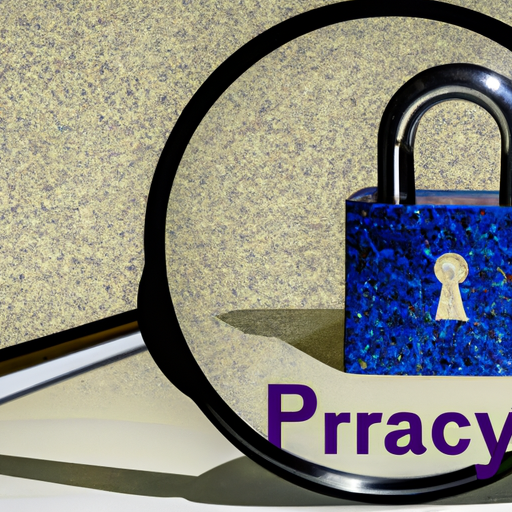In today’s digital landscape, privacy is a top concern for individuals and businesses alike. As technology continues to advance, it becomes increasingly important for companies to ensure their privacy policies are up to date and in compliance with relevant laws and regulations. A privacy policy audit can help businesses assess their current policies, identify potential risks, and make the necessary adjustments to protect their customers’ personal information. In this article, we will explore the key aspects of a privacy policy audit and why it is crucial for businesses to prioritize this process. Additionally, we will address some frequently asked questions about privacy policy audits to provide a comprehensive understanding of the topic.

Privacy Policy Audit
A privacy policy audit is a comprehensive evaluation of an organization’s privacy policy to ensure compliance with applicable laws and regulations, as well as to assess the effectiveness of its data collection and processing practices. This audit is crucial for businesses to maintain legal compliance, protect against legal and reputational risks, build trust with customers, and prevent data breaches and unauthorized access.
What is a Privacy Policy Audit?
Definition of Privacy Policy Audit
A privacy policy audit involves a systematic review of an organization’s privacy policy to assess its compliance with privacy laws and regulations, as well as its adherence to best practices in data collection and processing. It aims to identify any gaps or deficiencies in the policy and recommend updates or improvements to ensure legal compliance and data protection.
Purpose of a Privacy Policy Audit
The primary purpose of a privacy policy audit is to ensure that an organization’s privacy policy meets legal requirements and adequately protects the privacy rights of individuals whose personal information is collected and processed by the organization. It helps businesses identify privacy vulnerabilities and implement necessary measures to mitigate risks. Additionally, a privacy policy audit helps build trust with customers by demonstrating transparency and accountability in data handling practices.
Scope of a Privacy Policy Audit
A privacy policy audit typically covers various aspects of an organization’s privacy policy, including its content, clarity, and accessibility. It also involves assessing data collection and processing practices, data security measures, third-party data sharing agreements, and compliance with relevant laws and regulations.
Importance of Conducting a Privacy Policy Audit
Maintaining Legal Compliance
Conducting regular privacy policy audits is essential for businesses to ensure compliance with privacy laws and regulations. Laws such as the General Data Protection Regulation (GDPR) and the California Consumer Privacy Act (CCPA) require organizations to implement certain privacy measures and provide individuals with specific rights regarding their personal data. Failure to comply with these laws can result in severe legal consequences, including fines and legal actions. By conducting a privacy policy audit, businesses can identify any non-compliance issues and take corrective actions to avoid legal troubles.
Mitigating Legal and Reputational Risks
Non-compliance with privacy laws not only exposes businesses to legal risks but also poses significant reputational risks. Data breaches or unauthorized access to personal information can result in a loss of customer trust and damage a company’s reputation. By regularly auditing their privacy policy and data handling practices, businesses can identify potential risks and implement necessary security measures to prevent or mitigate these risks. Taking proactive steps to protect customer data demonstrates a commitment to data privacy and can enhance a company’s reputation.
Building Trust with Customers
In an era where data breaches and privacy violations are frequent occurrences, consumers are increasingly concerned about the privacy and security of their personal information. Having a transparent and comprehensive privacy policy is crucial for building trust with customers. Conducting a privacy policy audit helps businesses identify any gaps or deficiencies in their privacy practices and allows them to update their policy accordingly. By demonstrating a commitment to protecting customer privacy, businesses can gain the trust of their customers and differentiate themselves from their competitors.
Preventing Data Breaches and Unauthorized Access
One of the primary objectives of a privacy policy audit is to assess an organization’s data handling practices for vulnerabilities that could lead to data breaches or unauthorized access. By evaluating data collection, storage, and security measures, businesses can identify any weaknesses in their systems and take appropriate steps to address them. Implementing strong data protection measures reduces the risk of data breaches, protects the privacy of individuals, and helps businesses avoid costly legal and reputational consequences.
Benefits of a Privacy Policy Audit
Ensuring Compliance with Privacy Laws
A privacy policy audit helps businesses ensure compliance with privacy laws and regulations, such as the GDPR, CCPA, or industry-specific regulations. By reviewing and updating their privacy policy based on the audit findings, businesses can align their practices with legal requirements and mitigate the risk of non-compliance penalties.
Identifying Privacy Vulnerabilities
Conducting a privacy policy audit allows businesses to identify potential vulnerabilities in their data collection and processing practices. This includes assessing the adequacy of the security measures in place, evaluating data retention and deletion policies, and reviewing third-party data sharing agreements. Identifying vulnerabilities helps businesses take proactive steps to strengthen their privacy practices and protect against potential data breaches or unauthorized access.
Enhancing Transparency and Accountability
Transparency and accountability are crucial in today’s data-driven landscape. A privacy policy audit helps businesses ensure that their privacy policy is clear, easily accessible, and provides individuals with a comprehensive understanding of how their personal information is collected, used, and protected. By enhancing transparency and accountability, businesses can build trust with their customers and meet their privacy expectations.
Improving Customer Relations
Maintaining a strong relationship with customers is vital for the success of any business. By conducting a privacy policy audit and updating their privacy practices accordingly, businesses can demonstrate their commitment to protecting customer privacy and data security. Such proactive measures enhance customer trust, improve customer relations, and may even attract new customers who value data privacy.
Staying Ahead of Regulatory Changes
Privacy laws and regulations are constantly evolving, making it essential for businesses to stay updated with new requirements. Conducting regular privacy policy audits enables businesses to stay ahead of regulatory changes and ensures that their privacy policies remain compliant. By proactively addressing any necessary updates, businesses can avoid potential legal issues and maintain a strong compliance posture.
When Should You Conduct a Privacy Policy Audit?
After Significant Policy or Legislative Changes
Whenever significant policy changes or new legislation regarding privacy matters are enacted, businesses should consider conducting a privacy policy audit. This allows them to ensure that their policies and practices align with the new requirements and avoid any potential compliance issues.
Before Launching a New Product or Service
Before launching a new product or service that involves data collection or processing, businesses should conduct a privacy policy audit to assess the impact of the new offering on privacy practices. This helps identify any necessary updates to the privacy policy and ensure compliance with relevant laws and regulations.
Following Mergers or Acquisitions
Mergers or acquisitions can have implications for an organization’s privacy practices. When two organizations combine, it is important to conduct a privacy policy audit to identify any discrepancies or gaps in privacy policies and align them with the new organizational structure and practices.
Periodically to Ensure Ongoing Compliance
Given the evolving nature of privacy laws and regulations, businesses should conduct periodic privacy policy audits to ensure ongoing compliance. Regular audits help identify any changes in laws, regulations, or industry practices that may require updates to the privacy policy. By conducting audits at regular intervals, businesses can maintain a strong compliance posture and avoid any potential legal consequences.
The Privacy Policy Audit Process
A privacy policy audit typically involves several key steps to thoroughly evaluate an organization’s privacy policy and its alignment with applicable laws and best practices.
Step 1: Reviewing the Current Privacy Policy
The first step in a privacy policy audit is to obtain the current privacy policy document and review its content, structure, and clarity. This involves examining how the policy addresses key privacy principles, such as data collection, use, storage, security, and disclosure practices. The review should also consider whether the policy clearly communicates individuals’ rights and how they can exercise those rights.
Step 2: Identifying Applicable Laws and Regulations
Conducting legal research is crucial to identify the privacy laws and regulations that apply to the organization based on its geographical location, industry, and the nature of data collected. This step involves reviewing the requirements of key laws such as the GDPR, CCPA, or industry-specific regulations. It helps highlight the key compliance requirements that the organization needs to address in its privacy policy.
Step 3: Evaluating Data Collection and Processing Practices
In this step, the organization’s data collection and processing practices are evaluated to ensure compliance with applicable regulations. This involves understanding how personal data is collected, stored, and used, as well as assessing data security measures in place. Evaluating data retention and deletion policies and examining any third-party data sharing practices are also important aspects of this step.
Step 4: Assessing Privacy Policy Compliance
The next step is to assess the organization’s compliance with the privacy policy itself. This involves comparing the current practices with the policies outlined in the privacy policy document. Any gaps or inconsistencies between the policy and actual practices should be identified and addressed.
Step 5: Implementing Recommendations and Updates
Based on the findings of the previous steps, recommendations and updates should be made to improve the privacy policy and align it with legal requirements and best practices. This may involve revising the policy document, updating data collection and processing practices, enhancing data security measures, and providing clear instructions on how individuals can exercise their privacy rights.

Step 1: Reviewing the Current Privacy Policy
Obtaining the Current Privacy Policy
To begin the privacy policy audit process, it is crucial to obtain the current privacy policy document from the organization. This may involve accessing the document from the organization’s website or requesting it from the appropriate department or individual responsible for maintaining the privacy policy.
Reviewing the Privacy Policy Document
The privacy policy document should be carefully reviewed to understand its content, structure, and clarity. It should address key privacy principles, such as data collection, use, storage, security, and disclosure practices. The document should also clearly communicate individuals’ rights and provide instructions on how they can exercise those rights.
Comparing the Policy with Current Practices
After reviewing the privacy policy document, it is important to compare it with the actual data collection and processing practices of the organization. By doing so, any gaps or inconsistencies between the policy and the practices can be identified, allowing for necessary updates to the policy.
Identifying Gaps or Outdated Information
During the review process, it is essential to identify any gaps in the privacy policy or outdated information that needs to be revised. This may include missing information about specific data collection practices or outdated references to laws or regulations that are no longer in effect. Identifying and addressing these gaps will ensure the privacy policy accurately reflects the organization’s current privacy practices.
Step 2: Identifying Applicable Laws and Regulations
Conducting Legal Research
To accurately identify the privacy laws and regulations that apply to the organization, legal research should be conducted. This includes studying relevant national, regional, and industry-specific laws, regulations, and guidelines. It is important to consult reputable sources and legal professionals to understand the legal requirements that the organization must abide by.
Identifying Relevant Privacy Laws
Based on the legal research conducted, relevant privacy laws should be identified. This may include a combination of general privacy laws, such as the GDPR, CCPA, or regional data protection laws, as well as industry-specific regulations that apply to the organization. By understanding the specific legal requirements, the organization can ensure its privacy policy aligns with these laws.
Understanding Industry-Specific Regulations
Certain industries have specific privacy regulations that organizations must comply with. For example, the healthcare industry must adhere to the Health Insurance Portability and Accountability Act (HIPAA), while the financial sector must comply with the Gramm-Leach-Bliley Act (GLBA). Understanding any industry-specific regulations that apply to the organization is essential to ensure privacy policy compliance.
Highlighting Key Compliance Requirements
Upon identifying the applicable laws and regulations, it is crucial to highlight the key compliance requirements that the organization must address in its privacy policy. This includes understanding individuals’ rights, such as the right to access, rectify, or delete their personal information, as well as the organization’s obligations regarding data security, breach notification, and consent requirements.

Step 3: Evaluating Data Collection and Processing Practices
Understanding Data Collection Processes
In this step, the organization’s data collection processes should be thoroughly evaluated. This includes identifying the types of personal information collected, the purpose of the data collection, and the methods used to collect the information. Understanding the organization’s data collection practices is essential to ensure its privacy policy accurately reflects these practices.
Assessing Data Storage and Security Measures
Data storage and security measures should be carefully assessed to evaluate their adequacy. This involves determining where personal information is stored, how it is protected from unauthorized access or breaches, and which security measures, such as encryption or access controls, are in place to safeguard the data.
Reviewing Data Retention and Deletion Policies
Data retention and deletion policies should be reviewed to ensure compliance with privacy laws and regulations. This involves assessing the organization’s policies on how long personal information is retained, the purposes for which it is retained, and the processes in place for securely deleting or anonymizing data when it is no longer needed.
Examining Third-Party Data Sharing Practices
If the organization shares personal information with third parties, such as service providers or business partners, their data sharing practices should be examined. This includes assessing the organization’s agreements with these third parties to ensure compliance with privacy laws, data security requirements, and appropriate data handling practices.
Frequently Asked Questions
What is the purpose of a privacy policy?
The purpose of a privacy policy is to inform individuals about how their personal information is collected, used, and protected by an organization. It outlines the organization’s data collection and processing practices, explains individuals’ rights regarding their data, and provides instructions on how they can exercise those rights. A privacy policy helps build transparency and trust between organizations and individuals by demonstrating a commitment to protecting privacy and complying with applicable laws.
What information should be included in a privacy policy?
A privacy policy should include clear and comprehensive information about the organization’s data collection and processing practices. It should specify the types of personal information collected, the purposes for which the information is used, and the methods used to collect the data. Additionally, it should outline individuals’ rights, such as the right to access, rectify, or delete their data, and provide instructions on how to exercise those rights. The policy should also address data security measures, data sharing practices with third parties, and any other relevant information required by applicable privacy laws and regulations.
How often should a privacy policy be updated?
Privacy policies should be regularly reviewed and updated to ensure ongoing compliance with privacy laws and regulations. The frequency of updates may vary depending on various factors, such as changes in laws, regulations, or industry practices, significant policy or legislative changes, or the introduction of new products or services that impact data collection or processing. Businesses should aim to conduct privacy policy audits periodically to identify any necessary updates and ensure their policies remain accurate, transparent, and in compliance with applicable privacy requirements.
What are the consequences of not having a privacy policy?
Failure to have a privacy policy can have severe consequences for a business, both legally and in terms of reputation. Many privacy laws require organizations to have a privacy policy in place when collecting personal information. Non-compliance with these legal requirements can result in significant fines, penalties, or legal actions. Additionally, not having a privacy policy can undermine customer trust and lead to reputational damage. Individuals are increasingly concerned about the privacy and security of their personal information, and businesses that fail to address these concerns may risk losing customers and damaging their brand image.
Can a privacy policy protect my business from legal action?
While a privacy policy cannot fully protect a business from legal action, it plays a crucial role in demonstrating the organization’s commitment to privacy and compliance with applicable laws. A well-crafted and regularly updated privacy policy helps businesses establish transparency, build trust with customers, and meet legal requirements. In the event of legal action related to privacy or data protection, having a comprehensive privacy policy in place can demonstrate that the organization took reasonable steps to inform individuals about data collection and processing practices, and can serve as evidence of compliance efforts.
